Parametric Study of the Effect of Anchor Drive Bolt Geometry on Stress Distribution and Direction of Crack Formation in the Rock Medium
Highlights
- Bolt geometry significantly affects rock stress and crack initiation location.
- Cylindrical tips with chamfers promote deeper, more efficient crack paths.
- Numerical models show that a crack starts at the bolt–rock contact zone, not the anchor head.
- Design variations enable control over fracture volume and detachment zone.
- Findings support safer, non-explosive methods for selective rock fragmentation.
Abstract
1. Introduction
2. Materials and Methods
3. Results and Discussion
3.1. Experimental Validation
3.2. Model Limitations and Future Research Perspectives
- The application of a linear elastic material model, which is a significant simplification considering the wide variability in internal structure and deformation behavior across different rock types [80]. Disturbances in crack propagation trajectories (Figure 15) were observed even in hypothetically homogeneous grey sandstone from the “Zalas” mine (based on [59]).
- The assumed installation method, including anchor expansion and interaction with the rock medium, differs from the conventional behavior of pull-out-type undercutting anchors.
- Substantial variability in the mechanical properties of rock media, including Young’s modulus, Poisson’s ratio, Coulomb friction coefficient at the anchor–rock interface, moisture content, stratification, and natural fracturing of the rock mass;
- The detachment process in grey sandstone, being a sedimentary rock, may depend on the orientation of the bedding planes. In the present study, the borehole axis was oriented predominantly perpendicular to the sedimentation/bedding planes.
4. Conclusions
5. Summary and Conclusions
Author Contributions
Funding
Institutional Review Board Statement
Informed Consent Statement
Data Availability Statement
Conflicts of Interest
References
- Brown, E.T. Rock Engineering Design of Post-Tensioned Anchors for Dams—A Review. J. Rock Mech. Geotech. Eng. 2015, 7, 1–13. [Google Scholar] [CrossRef]
- Zou, W.-L.; Wang, X.-Q.; Vanapalli, S.K. Experimental Evaluation of Engineering Properties of GFRP Screw Anchors for Anchoring Applications. J. Mater. Civ. Eng. 2016, 28, 04016029. [Google Scholar] [CrossRef]
- Wils, L.; Wils, T.; Tremblay, M. Toward a Career Anchor Structure: An Empirical Investigation of Engineers. Relat. Ind. 2010, 65, 236–256. [Google Scholar] [CrossRef]
- Zheng, J.-J.; Dai, J.-G. Prediction of the Nonlinear Pull-out Response of FRPG round Anchors Using an Analytical Transfer Matrix Method. Eng. Struct. 2014, 81, 377–385. [Google Scholar] [CrossRef]
- Jonak, J.; Karpiński, R.; Siegmund, M.; Wójcik, A.; Jonak, K. Analysis of the Rock Failure Cone Size Relative to the Group Effect from a Triangular Anchorage System. Materials 2020, 13, 4657. [Google Scholar] [CrossRef]
- Jonak, K.; Karpiński, R.; Wójcik, A.; Jonak, J. Simulation of Rock Failure Cone Development Using a Modified Load-Transferring Anchor Design. Appl. Sci. 2025, 15, 7653. [Google Scholar] [CrossRef]
- Yilmaz, S.; Özen, M.A.; Yardim, Y. Tensile Behavior of Post-Installed Chemical Anchors Embedded to Low Strength Concrete. Constr. Build. Mater. 2013, 47, 861–866. [Google Scholar] [CrossRef]
- Contrafatto, L.; Cosenza, R. Predictionofthe Pull-out Strength of Chemical Anchors in Natural Stone. Fract. Struct. Integr. 2014, 8, 196–208. [Google Scholar] [CrossRef]
- Shaqour, F. Ground Anchors in an Aggressive Hydro-Environment. Bull. Eng. Geol. Environ. 2006, 65, 43–56. [Google Scholar] [CrossRef]
- Mottl, M.; Reiterman, P.; Pazderka, J. The Influence of Aggressive Environmental Conditions on the Adhesion of Applied Crystalline Materials. J. Compos. Sci. 2023, 8, 5. [Google Scholar] [CrossRef]
- Gruttadauria, A.; Barella, S.; Gerosa, R. An Overview of Austenitic Stainless-Steel Rock Anchors Damage in an Environment Rich with Chlorides. Eng. Fail. Anal. 2019, 100, 88–102. [Google Scholar] [CrossRef]
- Lamplmair-Irsigler, S.; Zeman, O.; Stierschneider, E.; Voit, K. Fastening in Rock Mass—Structural Design of Shallow Embedded Anchors in Inhomogeneous Substrate. Materials 2024, 17, 6044. [Google Scholar] [CrossRef]
- Cai, M. Rock Mass Characterization and Rock Property Variability Considerations for Tunneland Cavern Design. Rock Mech. Rock Eng. 2011, 44, 379–399. [Google Scholar] [CrossRef]
- Kong, P.; Jiang, L.; Shu, J.; Sainoki, A.; Wang, Q. Effect of Fracture Heterogeneity on Rock Mass Stability in a Highly Heterogeneous Underground Roadway. Rock Mech. Rock Eng. 2019, 52, 4547–4564. [Google Scholar] [CrossRef]
- Bokor, B.; Tóth, M.; Sharma, A. Fasteners in Steel Fiber Reinforced Concrete Subjected to Increased Loading Rates. Fibers 2018, 6, 93. [Google Scholar] [CrossRef]
- Tóth, M.; Bokor, B.; Sharma, A. Befestigungen Im Stahlfaserverstärkten Beton Bei Betonbruch—Stand Der Technik Und Bemessungsansatz/Anchorages in Steel Fiber Reinforced Concrete in the Case of Concrete Break out Failure—State of the Art and Design Concept. Bauingenieur 2021, 96, 254–265. [Google Scholar] [CrossRef]
- Tóth, M.; Bokor, B.; Sharma, A. Anchorage in Steel Fiber Reinforced Concrete–Concept, Experimental Evidence and Design Recommendations for Concrete Cone and Concrete Edge Break out Failure Modes. Eng. Struct. 2019, 181, 60–75. [Google Scholar] [CrossRef]
- Bokor, B.; Sharma, A.; Hofmann, J. Experimental Investigations on Concrete Cone Failure of Rectangular and Non-Rectangular Anchor Groups. Eng. Struct. 2019, 188, 202–217. [Google Scholar] [CrossRef]
- Bokor, B.; Sharma, A.; Pregartner, T. An Assessment Method to Ensure Applicability of Concrete Capacity Method for Design of Anchorages: Linear Force Distribution Approach. Struct. Concr. 2023, 24, 7249–7271. [Google Scholar] [CrossRef]
- Zheng, H.; Wu, X.; Jiang, Y.; Wang, G.; Wang, Z. Shear Behavior of Rock Joints Reinforced with Fully-Grouted and Energy-Absorbing Bolts Subjected to Shear Cycles. J. Rock Mech. Geotech. Eng. 2024, 17, 4314–4328. [Google Scholar] [CrossRef]
- Gkournelos, P.D.; Triantafillou, T.C.; Bournas, D.A. Seismic Upgrading of Existing Reinforced Concrete Buildings: A State-of-the-Art Review. Eng. Struct. 2021, 240, 112273. [Google Scholar] [CrossRef]
- Zhong, C.; Christopoulos, C. Self-Centering Seismic-Resistant Structures: Historical Overview and State-of-the-Art. Earthq. Spectra 2022, 38, 1321–1356. [Google Scholar] [CrossRef]
- Cao, X.-Y.; Shen, D.; Feng, D.-C.; Wang, C.-L.; Qu, Z.; Wu, G. Seismic Retrofitting of Existing Frame Buildings through Externally Attached Sub-Structures: State of the Art Review and Future Perspectives. J. Build. Eng. 2022, 57, 104904. [Google Scholar] [CrossRef]
- Jing, H.W.; Yang, S.Q.; Zhang, M.L.; Xu, G.A.; Chen, K.F. An Experimental Study on Anchorage Strength and Deformation Behavior of Large-Scale Jointed Rock Mass. Tunn. Undergr. Space Technol. 2014, 43, 184–197. [Google Scholar] [CrossRef]
- Wang, Y.; Li, C.; Cai, Z.; Zhu, G.; Zhou, J.; Yao, W. Mechanical Behaviors of Anchorage Interfaces in Layered Rocks with Fractures under Axial Loads. J. Earth Sci. 2023, 34, 354–368. [Google Scholar] [CrossRef]
- Wójcik, A.; Jonak, K.; Karpiński, R.; Jonak, J.; Kalita, M.; Prostański, D. Mechanism of Rock Mass Detachment Using Undercutting Anchors: A Numerical Finite Element Method (FEM) Analysis. Materials 2024, 17, 4468. [Google Scholar] [CrossRef]
- Caldwell, T. A Comparison of Non-Explosive Rock Breaking Techniques. In Proceedings of the 12th Australian Tunnelling Conference, Brisbane, Australia, 17–20 April 2005. [Google Scholar]
- Singh, S.P. Non-Explosive Applications of the PCF Concept for Underground Excavation. Tunn. Undergr. Space Technol. 1998, 13, 305–311. [Google Scholar] [CrossRef]
- Xu, K. Rock Fragmentation. In The ECPH Encyclopedia of Mining and Metallurgy; Springer Nature Singapore: Singapore, 2023; pp. 1–2. ISBN 978-981-19-0740-1. [Google Scholar]
- Zhu, C.; Huang, M.; Cai, Q.; Zuo, Y.; Tang, S.; Yin, Q. Complex Rock Mechanics Problems and Risk Prevention Solutions. Appl. Sci. 2025, 15, 755. [Google Scholar] [CrossRef]
- Li, G.; Ma, W.; Yu, C.; Tao, Z.; Wang, F. Optimization of Anchorage Support Parameters for Soft Rock Tunnel Based on Displacement Control Theory. J. Mt. Sci. 2023, 20, 2076–2092. [Google Scholar] [CrossRef]
- Li, M.; Ye, L.; Feng, J.; Fang, Y.; Wen, H.; Wu, X. Failure Mechanism and Control Technology of Soft-Rock Roadways Subjected to High Structural Stress. Front. Earth Sci. 2024, 12, 1473108. [Google Scholar] [CrossRef]
- Wang, D.; He, F.; Chen, D.; Bascompta, M.; Wang, X.; Xu, C.; Liu, B.; Tian, W. Mechanism of Enhanced Control and Technological Application of Surrounding Rock Anchoring in Fully Mechanized Caving Face of Extra-Thick Coal Seams. Processes 2025, 13, 1216. [Google Scholar] [CrossRef]
- Zheng, H.; Wu, X.; Jiang, Y.; Wang, G.; Li, B. Insights into Velocity-Dependent Shear Characteristics of Bolted Rock Joints: A Comparative Study of Fully-Grouted and Energy-Absorbing Bolts. Int. J. Rock Mech. Min. Sci. 2024, 183, 105910. [Google Scholar] [CrossRef]
- Wang, Z.; Liao, L.; Guo, S.; Zheng, H.; Wu, X. Numerical Investigation of Bolted Rock Joints under Varying Normal Stressand Joint Roughness Coefficient Conditions. Front. Earth Sci. 2024, 12, 1402708. [Google Scholar] [CrossRef]
- Deutsches Institut für Bautechnik. European Technical Assessment ETA-18/0629 of 4 September 2018; Deutsches Institut für Bautechnik: Berlin, Germany, 2018. [Google Scholar]
- American Certification Institute. Building Code Requirements for Structural Concrete (ACI 318–19) Commentary on Building Code Requirements for Structural Concrete: ACI 318M ERTA—2020; HISMarkit: New York, NY, USA, 2020. [Google Scholar]
- Hilti. Technical Datasheet Update: Dec-17, HDA Undercut Anchor; Hilti: Schaan, Liechtenstein, 2017. [Google Scholar]
- Hilti. Hilti Mechanical Anchors Catalog; Hilti: Schaan, Liechtenstein, 2025. [Google Scholar]
- MIYANAGA Co., Ltd. ANZEX Undercut Anchor System Installation Manual (ANZEX-D); MIYANAGA Co., Ltd.: Miki, Japan, 2020. [Google Scholar]
- Jonak, J.; Karpiński, R.; Wójcik, A. Numerical Analysis of the Effect of Embedment Depth on the Geometry of the Cone Failure. J. Phys. Conf. Ser. 2021, 2130, 012012. [Google Scholar] [CrossRef]
- Jonak, J.; Karpiński, R.; Wójcik, A. Numerical Analysis of Under cut Anchor Effect on Rock. J. Phys. Conf. Ser. 2021, 2130, 012011. [Google Scholar] [CrossRef]
- Zhang, B.; Chen, Z. Numerical Simulation and Parametric Study of Pull out Behavior of Anchor Studs in Normal-strength and High-strength Concrete. Struct. Concr. 2025, suco.70278. [Google Scholar] [CrossRef]
- Fuchs, W.; Eligehausen, R.; Breen, J.E. Concrete Capacity Design (CCD) Approach for Fastening to Concrete. Struct. J. 1995, 92, 73–94. [Google Scholar] [CrossRef]
- Di Nunzio, G. A Literature Review about the Head-Size Effect on the Capacity of Cast-in Anchors. In Proceedings of the 10th International Conference on Fracture Mechanics of Concrete and Concrete Structures, Bayonne, France, 23–26 June 2019. [Google Scholar]
- Hariyadi; Munemoto, S.; Sonoda, Y. Experimental Analysis of Anchor Bolt in Concrete under the Pull-Out Loading. Procedia Eng. 2017, 171, 926–933. [Google Scholar] [CrossRef]
- Kadima Lukanu Lwa Nzambi, A.; Bule Ntuku, J.; De Oliveira, D.R.C. Effect of Adhesive through Pilot Pull-Out Tests on Handcrafted Headed Studs Postinstalled in Steel Fiber Concrete. Pract. Period. Struct. Des. Constr. 2021, 26, 05021005. [Google Scholar] [CrossRef]
- Elgehausen, R.; Sawade, G. A Fracture Mechanics Based Description of the Pull-out Behavior of Headed Studs Embedded in Concrete. Communities Collect. 1989. [Google Scholar] [CrossRef]
- Eligehausen, R.; Mallée, R.; Silva, J.F. Anchorage in Concrete Construction; Wiley Library: Hoboken, NJ, USA, 2006; Volume 10. [Google Scholar]
- Henriques, J.; Raposo, J.M.; da Silva, L.S.; Neves, L.C. Tensile Resistance of Steel-Reinforced Anchorages: Experimental Evaluation. ACI Struct. J. 2013, 110, 2. [Google Scholar] [CrossRef]
- Zhuang, L.-D.; Chen, H.-B.; Ma, Y.; Ding, R. Research on Whole-Process Tensile Behavior of Headed Studs inSteel–Concrete Composite Structures. Int. J. Concr. Struct. Mater. 2021, 15, 24. [Google Scholar] [CrossRef]
- Malikova, L.; Miarka, P. Parametric Study on the Effect of Anchor’s Geometry on the Stress Distribution and Crack Initiation Direction in a Concrete Body. Fract. Struct. Integr. 2025, 19, 131–138. [Google Scholar] [CrossRef]
- Mahrenholtz, P. Experimental Performance and Recommendations for Qualification of Post-Installed Anchors for Seismic Applications; Inst. für Werkstoffe im Bauwesen: Stuttgart, Germany, 2013; ISBN 3-9811682-7-5. [Google Scholar]
- Grindheim, B.; Li, C.C.; Høien, A.H.; Lia, L. Behavior of a Rock Mass in Uplift Field Tests of Rock Anchors. Rock Mech. Rock Eng. 2024, 57, 2339–2364. [Google Scholar] [CrossRef]
- Lamplmair, S.; Zeman, O.; Voit, K. Factors Influencing the Load-Bearing Capacity of Rock as Base Material forPost-Installed Anchors. Materials 2021, 14, 5130. [Google Scholar] [CrossRef]
- Genco, A.; Ciantia, M.O.; Previtali, M.; Brown, M.; Ivanovic, A.; Cresswell, N.; Twomey, V. Large Deformation Numerical Assessment of Rock Anchor Response under Axial Loading for Offshore Renewable Energy Applications. Comput. Geotech. 2024, 173, 106563. [Google Scholar] [CrossRef]
- Ferrari, A.; Rosone, M.; Ziccarelli, M.; Gottardi, G. (Eds.) Geotechnical Engineering in the Digital and Technological Innovation Era; Springer Series in Geomechanics and Geoengineering; Springer: Cham, Switzerland, 2023; ISBN 978-3-031-34760-3. [Google Scholar]
- Jonak, J.; Karpiński, R.; Siegmund, M.; Machrowska, A.; Prostański, D. Experimental Verification of Standard Recommendations for Estimating the Load-Carrying Capacity of Undercut Anchorsin Rock Material. Adv. Sci. Technol. Res. J. 2021, 15, 230–244. [Google Scholar] [CrossRef]
- Jonak, J.; Wójcik, A.; Karpiński, R.; Jonak, K. Effect of Under cut Bolt Anchor Depth on Failure Cone Geometry: A Numerical FEM Analysis and Experimental Verification. Materials 2025, 18, 686. [Google Scholar] [CrossRef]
- Krzysztof, K.; Piotr, M. Methods of Mechanical Mining of Compact-Rock—A Comparison of Efficiency and Energy Consumption. Energies 2019, 12, 3562. [Google Scholar] [CrossRef]
- Hasilová, K.; Gajewski, J. The Use of Kernel Density Estimates for Classification of Ripping Tool Wear. Tunn. Undergr. Space Technol. 2019, 88, 29–34. [Google Scholar] [CrossRef]
- Gajewski, J.; Jonak, J. Utilisation of Neural Networks to Identify the Status of the Cutting Tool Point. Tunn. Undergr. Space Technol. 2006, 21, 180–184. [Google Scholar] [CrossRef]
- Jedliński, Ł.; Gajewski, J. Optimal Selection of Signal Features in the Diagnostics of Mining Head Tools Condition. Tunn. Undergr. Space Technol. 2019, 84, 451–460. [Google Scholar] [CrossRef]
- Liang, F.; Pei, C.; Luo, W.; You, M.; Tan, F. Numerical Simulation Analysis of Different Excavation Parameters for TBM3DDisc Cutters Based on the Discrete Element Method. Appl. Sci. 2024, 15, 38. [Google Scholar] [CrossRef]
- Vališ, D.; Forbelská, M.; Vintr, Z.; Gajewski, J. Degradation Process and Failure Estimation of Drilling System Based on RealDataand Diffusion Process Supported by State Space Models. Measurement 2020, 164, 108076. [Google Scholar] [CrossRef]
- Wang, Y.-T.; Zhou, X.-P.; Kou, M.-M. Three-Dimensional Numerical Study on the Failure Characteristics of Intermittent Fissures under Compressive-Shear Loads. Acta Geotech. 2019, 14, 1161–1193. [Google Scholar] [CrossRef]
- Zhou, X.; Wang, Y.; Qian, Q. Numerical Simulation of Crack Curving and Branching in Brittle Materials under Dynamic Loads Using the Extended Non-Ordinary State-Based Peridynamics. Eur. J. Mech. A Solids 2016, 60, 277–299. [Google Scholar] [CrossRef]
- Zhou, X.-P.; Gu, X.-B.; Wang, Y.-T. Numerical Simulations of Propagation, Bifurcation and Coalescence of Cracks in Rocks. Int. J. Rock Mech. Min. Sci. 2015, 80, 241–254. [Google Scholar] [CrossRef]
- Morshedlou, A.; Rostami, J.; Moradian, O. Introducing a New Model for Prediction of Mean Cutting Forces Acting on Conical Pick Cutters. Rock Mech. Rock Eng. 2024, 57, 1695–1716. [Google Scholar] [CrossRef]
- Deng, L.-C.; Zhang, F.-B.; Li, X.-Z.; Zhang, C.; Ji, Y.-K.; Wu, Y. Experimental and Numerical Investigations on Rock Breaking of TBM Disc Cutter Based on a Novel Platform with Rotational Cutting. Rock Mech. Rock Eng. 2023, 56, 1415–1436. [Google Scholar] [CrossRef]
- Vališ, D.; Gajewski, J.; Forbelská, M.; Vintr, Z.; Jonak, J. Drilling Head Knives Degradation Modelling Based on Stochastic Diffusion Processes Backed upby State Space Models. Mech. Syst. Signal Process. 2022, 166, 108448. [Google Scholar] [CrossRef]
- Cao, Y.; Zhang, Q.; Zhang, S.; Tian, Y.; Dong, X.; Song, X.; Wang, D. Optimization of Rock-Cutting Tools: Improvements in Structural Design and Process Efficiency. Computation 2025, 13, 152. [Google Scholar] [CrossRef]
- Jonak, J.; Karpiński, R.; Wójcik, A. Influence of the Undercut Anchor Head Angle on the Propagation of the Failure Zone of the Rock Medium—Part II. Materials 2021, 14, 3880. [Google Scholar] [CrossRef] [PubMed]
- Jonak, J.; Karpiński, R.; Wójcik, A. Influence of the Undercut Anchor Head Angle on the Propagation of the Failure Zone of the Rock Medium. Materials 2021, 14, 2371. [Google Scholar] [CrossRef] [PubMed]
- Siegmund, M.; Jonak, J. Analysis of the Process of Loosening the Rocks with Different Strength Properties Using the Undercutting Bolts. In IOP Conference Series: Materials Science and Engineering; IOP Publishing: Bristol, UK, 2019; Volume 679, p. 012014. [Google Scholar] [CrossRef]
- Jonak, J.; Siegmund, M. FEM 3D Analysis of Rock Cone Failure Range during Pull-out of Undercut Anchors. In IOP Conference Series: Materials Science and Engineering; IOP Publishing: Bristol, UK, 2019; Volume 710, p. 012046. [Google Scholar] [CrossRef]
- Jonak, J.; Karpiński, R.; Wójcik, A. Influence of Anchor Depth and Friction Coefficient Between Anchor and Rock on the Trajectory of Rock Masses Detachment. Adv. Sci. Technol. Res. J. 2023, 17, 290–298. [Google Scholar] [CrossRef]
- Jonak, J.; Karpiński, R.; Wójcik, A.; Siegmund, M.; Kalita, M. Determining the Effect of Rock Strength Parameters on the Breakout Area Utilizing the New Design of the Undercut/Breakout Anchor. Materials 2022, 15, 851. [Google Scholar] [CrossRef]
- Wójcik, A.; Jonak, J.; Karpiński, R.; Jonak, K.; Prostański, D.; Kaczyński, R. A Numerical Study of the Influence of Cone Angle of the Breakout Anchor Head on the Crack Trajectory of the Medium. Adv. Sci. Technol. Res. J. 2024, 18, 101–112. [Google Scholar] [CrossRef]
- Zhao, Z.; Zhou, X.-P. Digital Microscopic Multiphase Heterogeneity Representation and Its Effects on Micromechanics and Cracking Behaviors of Geomaterials. Rock Mech. Rock Eng. 2024, 57, 7443–7459. [Google Scholar] [CrossRef]
- Koca, M.Y.; Kincal, C.; Arslan, A.T.; Yilmaz, H.R. Anchor Application in Karatepe Andesite Rock Slope, Izmir—Türkiye. Int. J. Rock Mech. Min. Sci. 2011, 48, 245–258. [Google Scholar] [CrossRef]
- Zhao, Z.; Zhou, X.-P. A Comprehensive Review of Various AI-Based Segmentation Algorithms for Multiscale Rocks: Principles, Evaluations, Simple Applications and Future Directions. Rock Mech. Rock Eng. 2025, 2025, 1–36. [Google Scholar] [CrossRef]
- Zhou, X.-P.; Zhao, Z.; Li, Z. Cracking Behaviors and Hydraulic Properties Evaluation Based on Fractural Microstructure Models in Geomaterials. Int. J. Rock Mech. Min. Sci. 2020, 130, 104304. [Google Scholar] [CrossRef]
- Zhao, Z.; Zhou, X. Microscopic Characterizations of Heterogeneous Pores, ITZs, Multiple-Solids, and Their Impacts on Damage Property of Sandstone by Low-High Resolution 3D Reconstruction. Geophys. Res. Lett. 2021, 48, e2021GL095001. [Google Scholar] [CrossRef]
- Cook, R.A. Behavior and Design of Ductile Multiple-Anchor Steel-to-Concrete Connections; The University of Texas at Austin: Austin, TX, USA, 1989; ISBN 979-8-206-89520-9. [Google Scholar]
- Gontarz, J.; Podgórski, J. Numerical Analysis of Crack Propagation in a Pull-out Test. In MATEC Web of Conferences; EDP Sciences: Les Ulis, France, 2019; Volume 252, p. 08001. [Google Scholar] [CrossRef]
- ABAQUS, Version 2019; Dassault Systèmes Simulia Corporation: Vélizy-Villacoublay, France, 2019.
- Jnak, J.; Siegmund, M.; Karpiński, R.; Wójcik, A. Three-Dimensional Finite Element Analysis of the Undercut Anchor Group Effect in Rock Cone Failure. Materials 2020, 13, 1332. [Google Scholar] [CrossRef]
- Rabbat, B.G.; Russell, H.G. Friction Coefficient of Steel on Concrete or Grout. J. Struct. Eng. 1985, 111, 505–515. [Google Scholar] [CrossRef]
- Gotarz, J.; Podgórski, J.; Jonak, J.; Kalita, M.; Siegmund, M. Comparison Between Numerical Analysis and Actual Results for a Pull-Out Test. Eng. Trans. 2019, 67, 311–331. [Google Scholar] [CrossRef]
- Walter, H.; Baillet, L.; Brunet, M. Contact Analysis for the Modelling of Anchors in Concrete Structures. WIT Trans. Eng. Sci. 1997, 14, 341–349. [Google Scholar]
- Jonak, J.; Karpiński, R.; Wójcik, A.; Siegmund, M. The Influence of the Physical-Mechanical Parameters of Rock on the Extent of the Initial Failure Zone under the Action of an Undercut Anchor. Materials 2021, 14, 1841. [Google Scholar] [CrossRef]
- Wysmulski, P. Analysis of the Effect of an Open Hole on the Buckling of a Compressed Composite Plate. Materials 2024, 17, 1081. [Google Scholar] [CrossRef]
- Wysmulski, P. Failure Mechanism of Tensile CFRP Composite Plates with Variable Hole Diameter. Materials 2023, 16, 4714. [Google Scholar] [CrossRef]
- Gontarz, J.; Podgórski, J. Prediction of Crack Path in Concrete-like Composite using Extended Finite Element Method. Adv. Sci. Technol. Res. J. 2025, 19, 2. [Google Scholar] [CrossRef]
- Falkowicz, K. Numerical Investigations of Perforated CFRPZ-Cross-Section Profiles, under Axial Compression. Materials 2022, 15, 6874. [Google Scholar] [CrossRef]
- Falkowicz, K. Validation of Extension-Bending and Extension-Twisting Coupled Laminates in Elastic Element. Adv. Sci. Technol. Res. J. 2023, 17, 309–319. [Google Scholar] [CrossRef]
- Jing, L. A Review of Techniques, Advances and Outstanding Issues in Numerical Modelling for Rock Mechanics and Rock Engineering. Int. J. Rock Mech. Min. Sci. 2003, 40, 283–353. [Google Scholar] [CrossRef]
- Jing, L.; Hudson, J.A. Numerical Methods in Rock Mechanics. Int. J. Rock Mech. Min. Sci. 2002, 39, 409–427. [Google Scholar] [CrossRef]
- Romero, A.; Galvín, P.; Domínguez, J. 3D Non-Linear Time Domain FEM–BEM Approachto Soil–Structure Interaction Problems. Eng. Anal. Bound. Elem. 2013, 37, 501–512. [Google Scholar] [CrossRef]
- Romero, A.; Galvín, P.; Tadeu, A. An Accurate Treatment of Non-Homogeneous Boundary Conditions for Development of the BEM. Eng. Anal. Bound. Elem. 2020, 116, 93–101. [Google Scholar] [CrossRef]
- Min, K.B.; Park, B.; Kim, H.; Cho, J.W.; Jing, L. Experimental and Numerical Anisotropic Rock Mechanics. Rock Mech. Eng. 2017, 1, 108–138. [Google Scholar]
- Clouteau, D.; Elhabre, M.L.; Aubry, D. Periodic BEM and FEM-BEM Coupling. Comput. Mech. 2000, 25, 567–577. [Google Scholar] [CrossRef]
- Aimi, A.; Desiderio, L.; Fedeli, P.; Frangi, A. A Fast Boundary-Finite Element Approach for Estimating Anchor Losses in Micro-Electro-Mechanical System Resonators. Appl. Math. Model. 2021, 97, 741–753. [Google Scholar] [CrossRef]
- Saleh, A.L.; Aliabadi, M.H. Boundary Element Analysis of the Pullout Behaviour of an Anchor Bolt Embedded in Concrete. Mech. Cohesive-Frict. Mater. Int. J. Exp. Model. Comput. Mater. Struct. 1996, 1, 235–249. [Google Scholar] [CrossRef]
- Tang, C.A.; Yang, W.T.; Fu, Y.F.; Xu, X.H. A New Approach to Numerical Method of Modelling Geological Processes and Rock Engineering Problems—Continuum to Discontinuum and Linearity to Nonlinearity. Eng. Geol. 1998, 49, 207–214. [Google Scholar] [CrossRef]
- Stead, D.; Eberhardt, E.; Coggan, J.S. Developments in the Characterization of Complex Rock Slope Deformation and Failure Using Numerical Modelling Techniques. Eng. Geol. 2006, 83, 217–235. [Google Scholar] [CrossRef]
- Wei, X.; Li, Z.; Zhao, G. A Review of Multiscale Numerical Modeling of Rock Mechanics and Rock Engineering. Deep Undergr. Sci. Eng. 2024, dug2.12127. [Google Scholar] [CrossRef]
- Tan, X.; Konietzky, H.; Chen, W. Numerical Simulation of Heterogeneous Rock Using Discrete Element Model Based on Digital Image Processing. Rock Mech. Rock Eng. 2016, 49, 4957–4964. [Google Scholar] [CrossRef]
- Zhang, F.; Damjanac, B.; Maxwell, S. Investigating Hydraulic Fracturing Complexity in Naturally Fractured Rock Masses Using Fully Coupled Multiscale Numerical Modeling. Rock Mech. Rock Eng. 2019, 52, 5137–5160. [Google Scholar] [CrossRef]
- Szabelski, J.; Karpiński, R.; Machrowska, A. Application of an Artificial Neural Network in the Modelling of Heat Curing Effects on the Strength of Adhesive Joints at Elevated Temperature with Imprecise Adhesive Mix Ratios. Materials 2022, 15, 721. [Google Scholar] [CrossRef] [PubMed]
- Siegmund, M.; Kalita, M.; Bałaga, D.; Kaczmarczyk, K.; Józef, J. Testing the Rocks Loosening Process by Undercutting Anchors. Stud. Geotech. Mech. 2020, 42, 276–290. [Google Scholar] [CrossRef]
- Jonak, J.; Karpiński, R.; Wójcik, A.; Siegmund, M. The Effect of Undercut Anchor Diameter on the Rock Failure Cone Area in Pullout Tests. Adv. Sci. Technol. Res. J. 2022, 16, 261–270. [Google Scholar] [CrossRef]
- Gontarz, J.; Podgórski, J.; Siegmund, M. Comparison of Crack Propagation Analyses in a Pull-out Test. In AIP Conference Proceedings; Lublin, Poland, 13–16 September 2017, AIP Publishing: Lublin, Poland, 2018; Volume 1922, p. 130011. Available online: https://pubs.aip.org/aip/acp/article/1922/1/130011/608644/Comparison-of-crack-propagation-analyses-in-a-pull (accessed on 1 May 2025).
- Costagliola, G.; Bosia, F.; Pugno, N.M. Tuning of Frictional Properties in Torsional Contact by Means of Disk Grading. Friction 2022, 10, 787–802. [Google Scholar] [CrossRef]
- Chen, K.; Zhang, D.; Yang, X.; Cui, X.; Zhang, X.; Wang, Q. Research on Torsional Friction Behavior and Fluid Load Support of PVA/HA Composite Hydrogel. J. Mech. Behav. Biomed. Mater. 2016, 62, 182–194. [Google Scholar] [CrossRef]
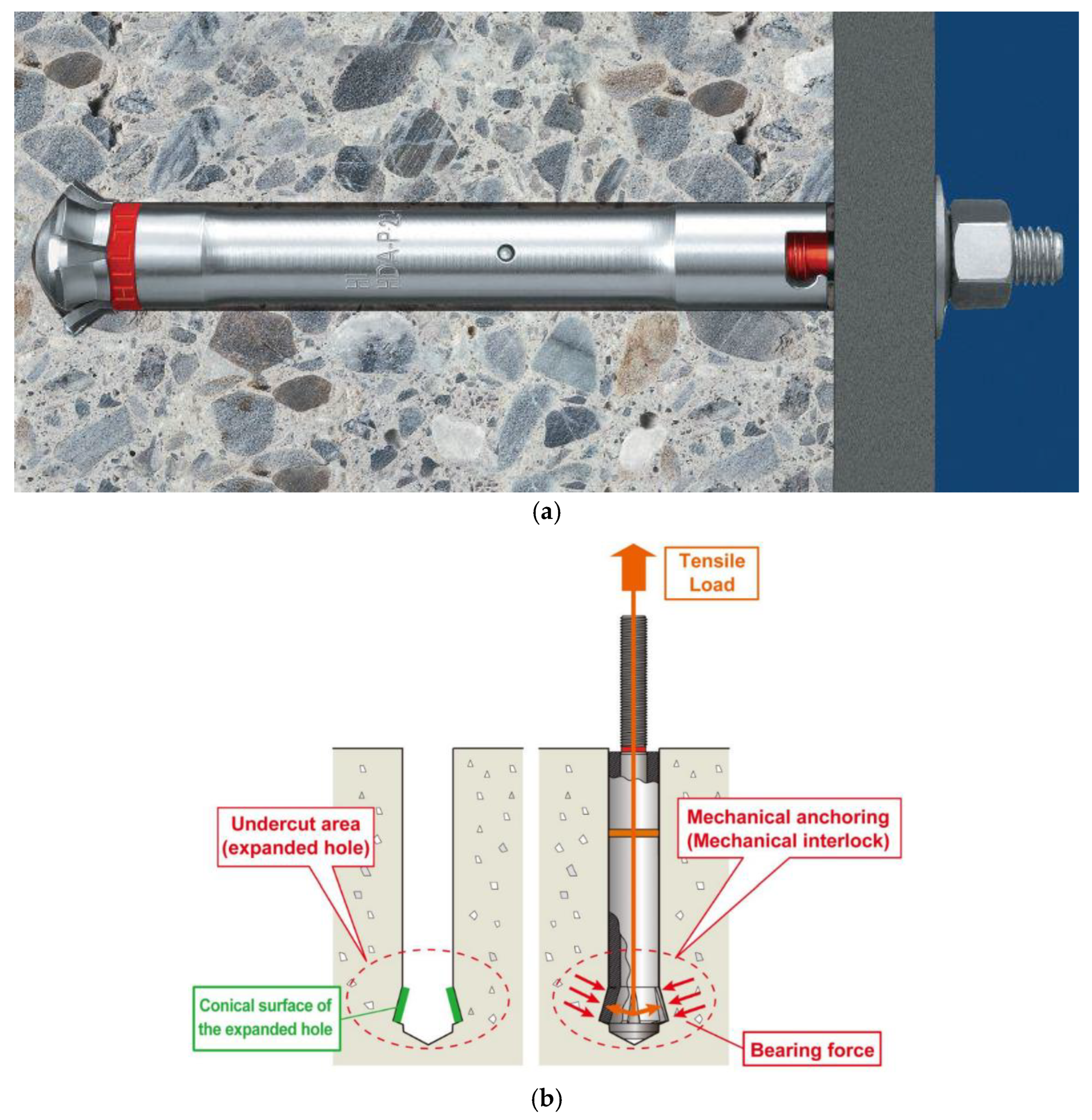

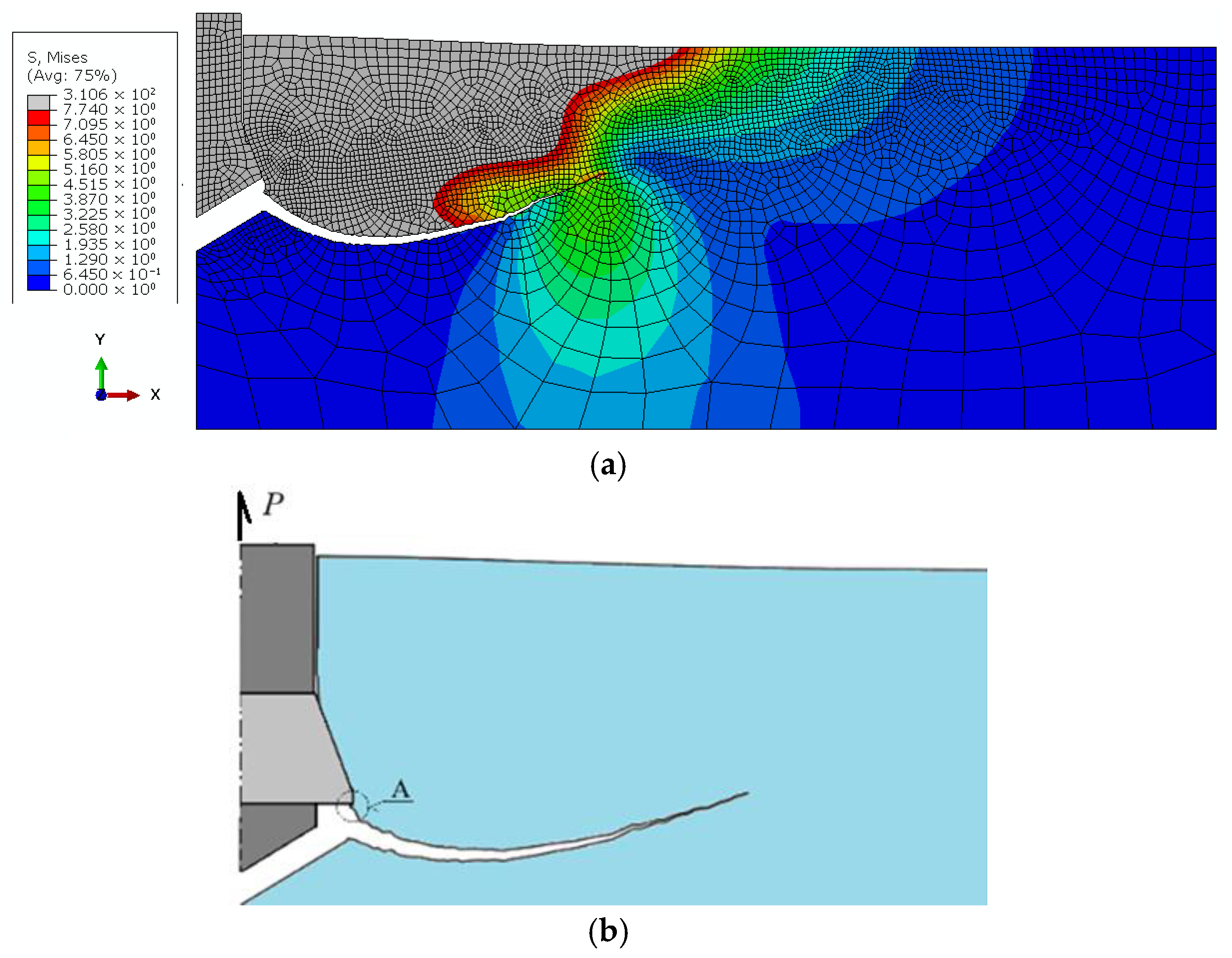

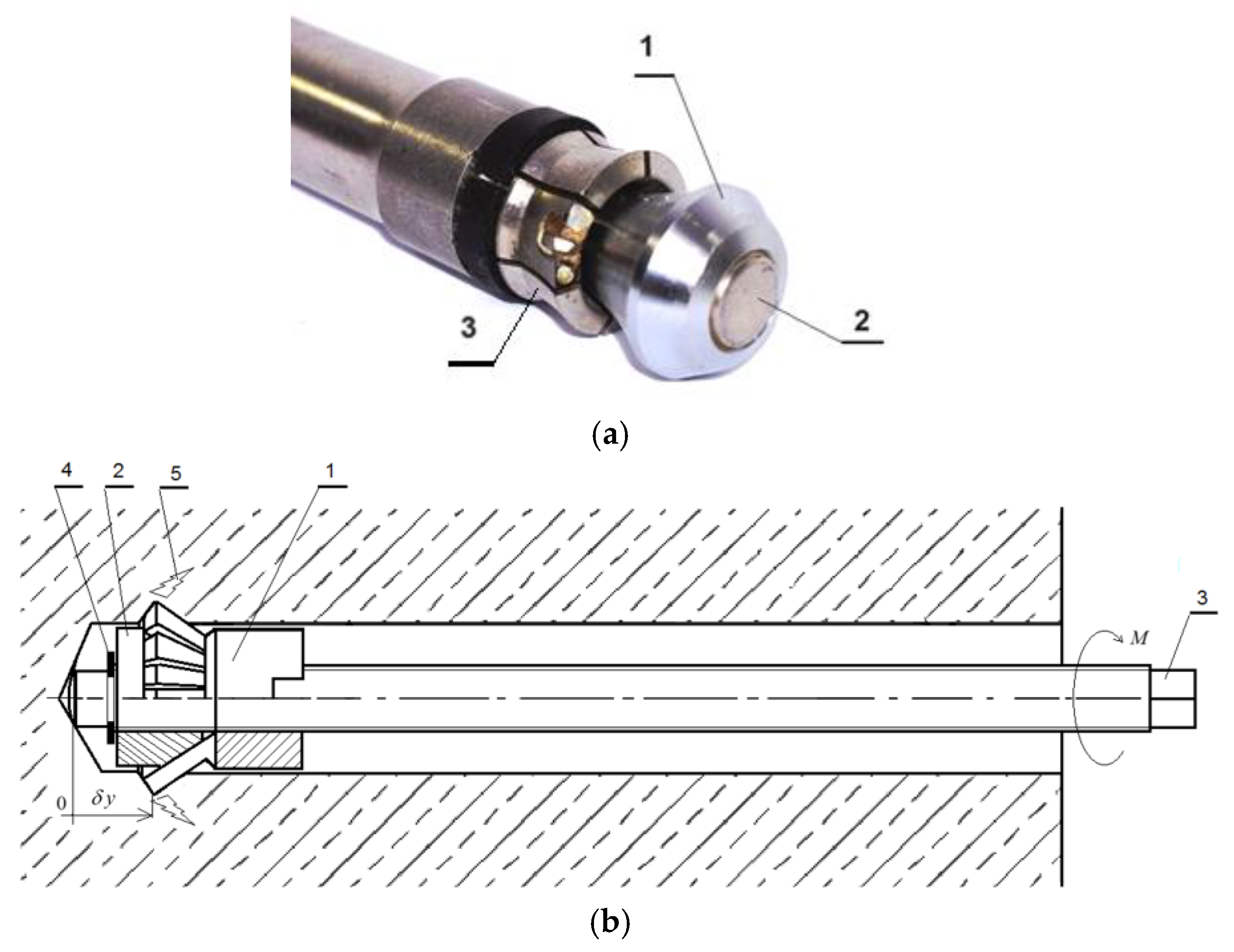

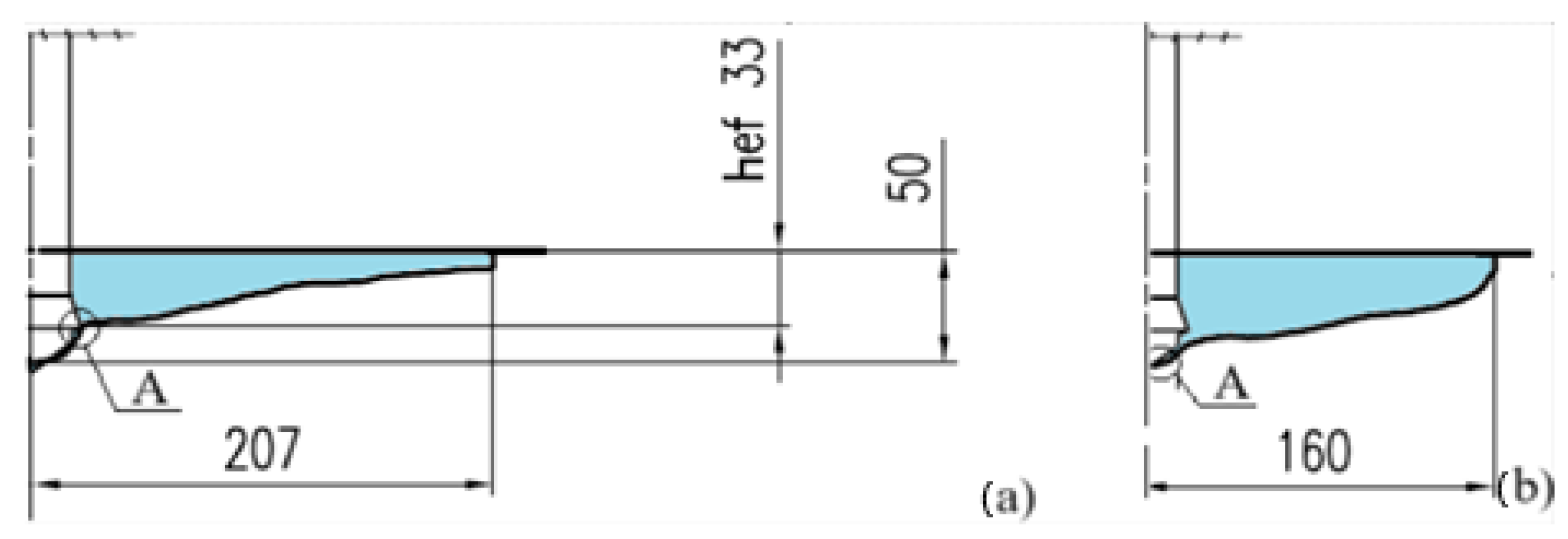


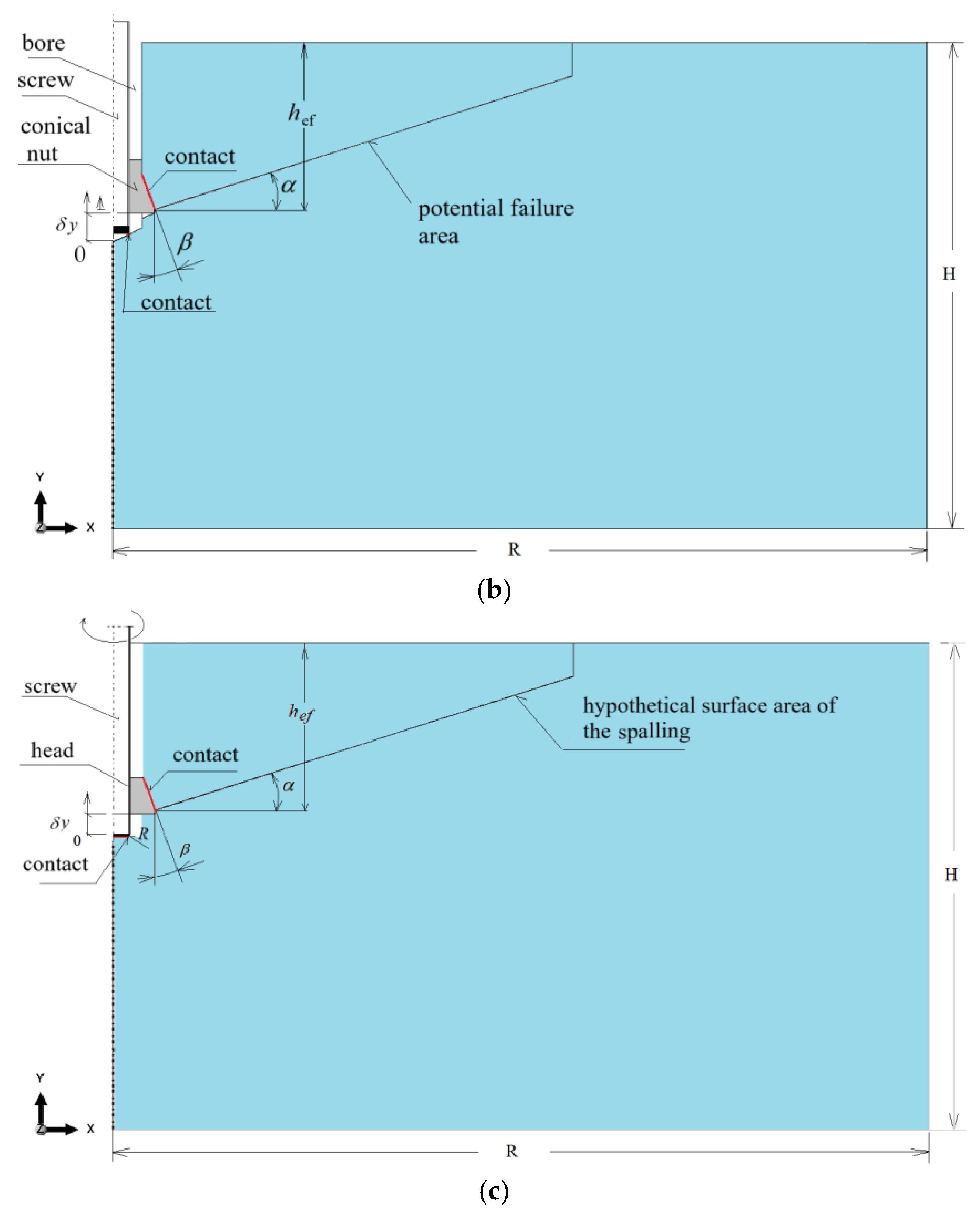
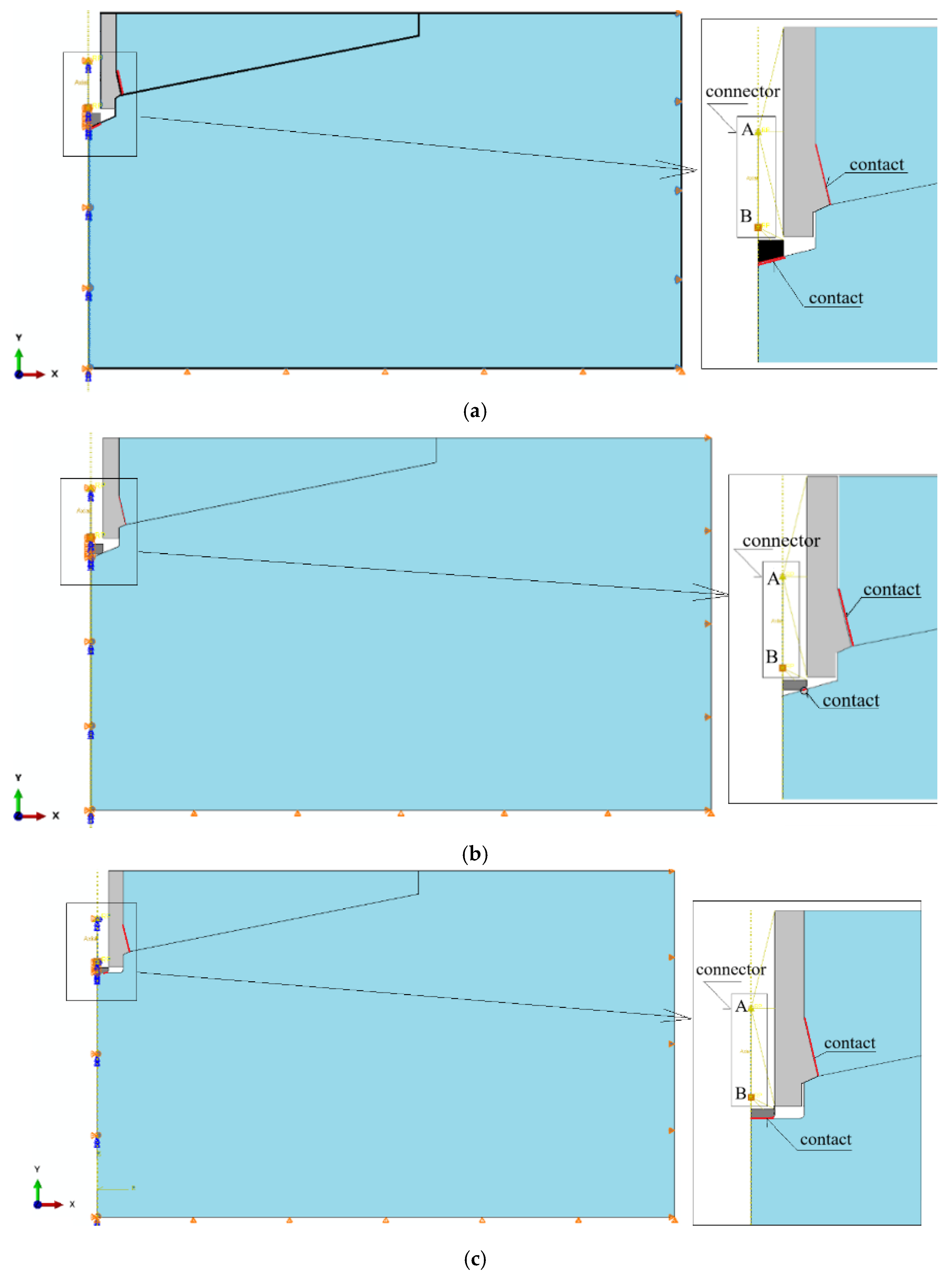

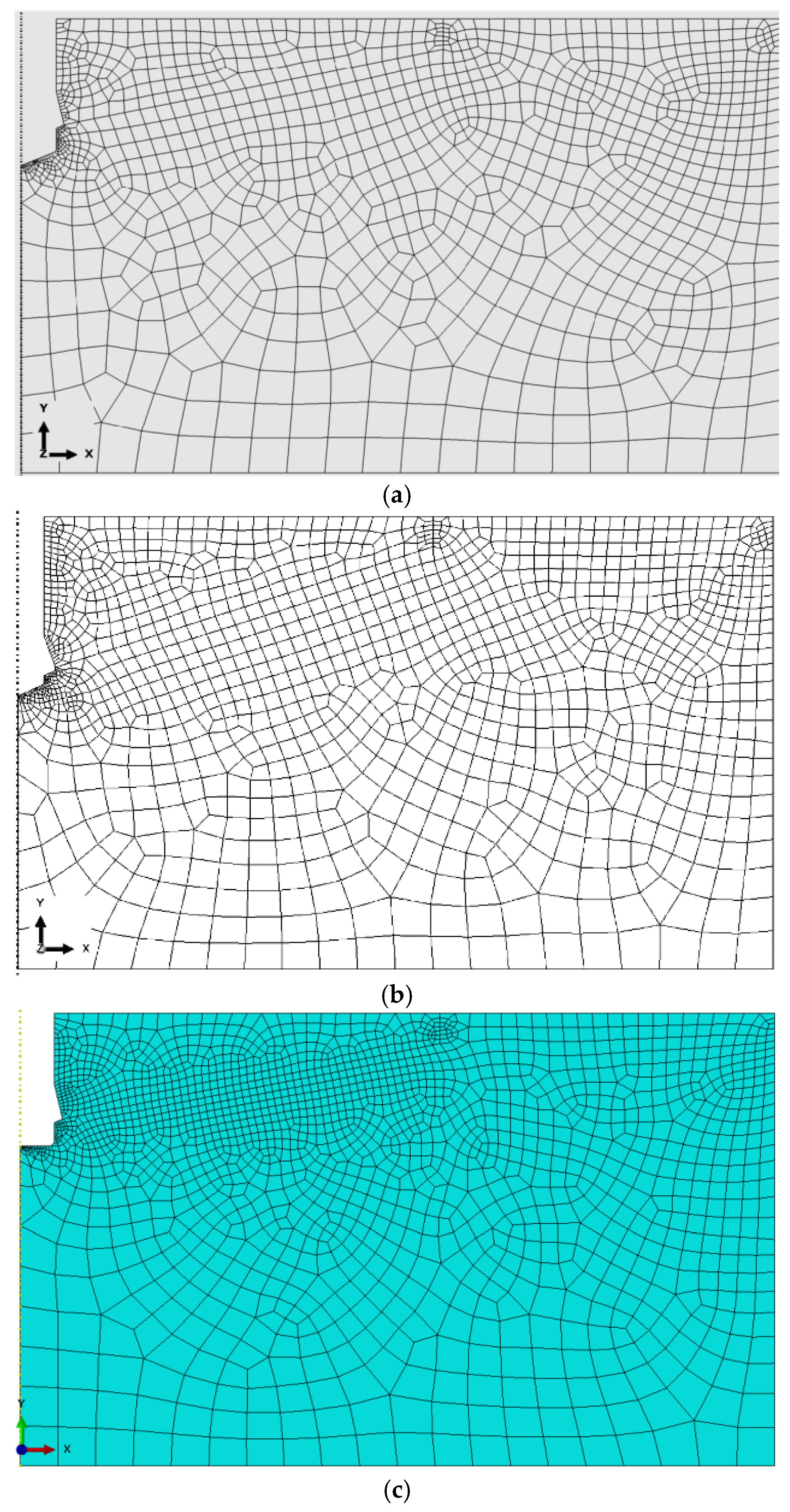

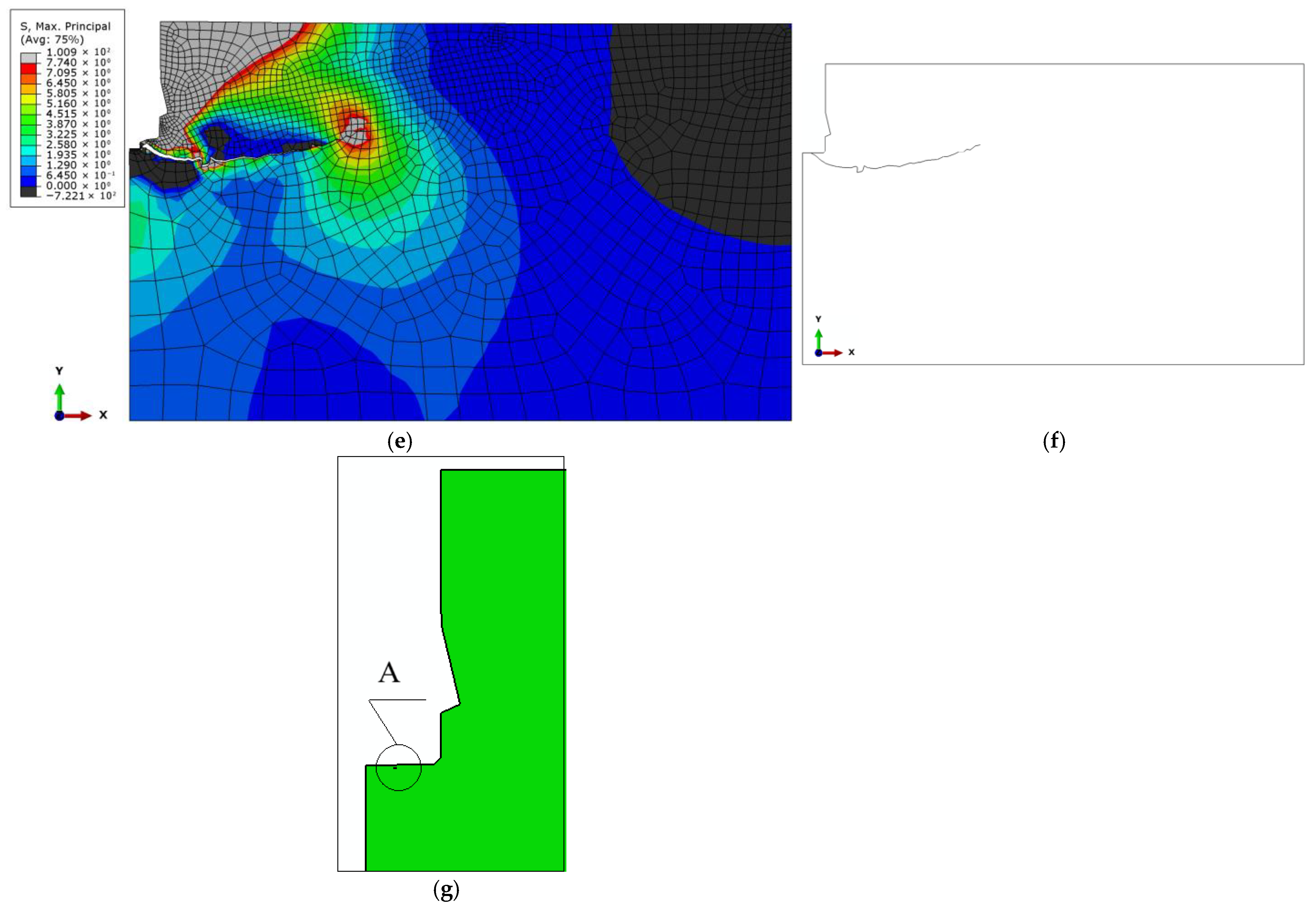



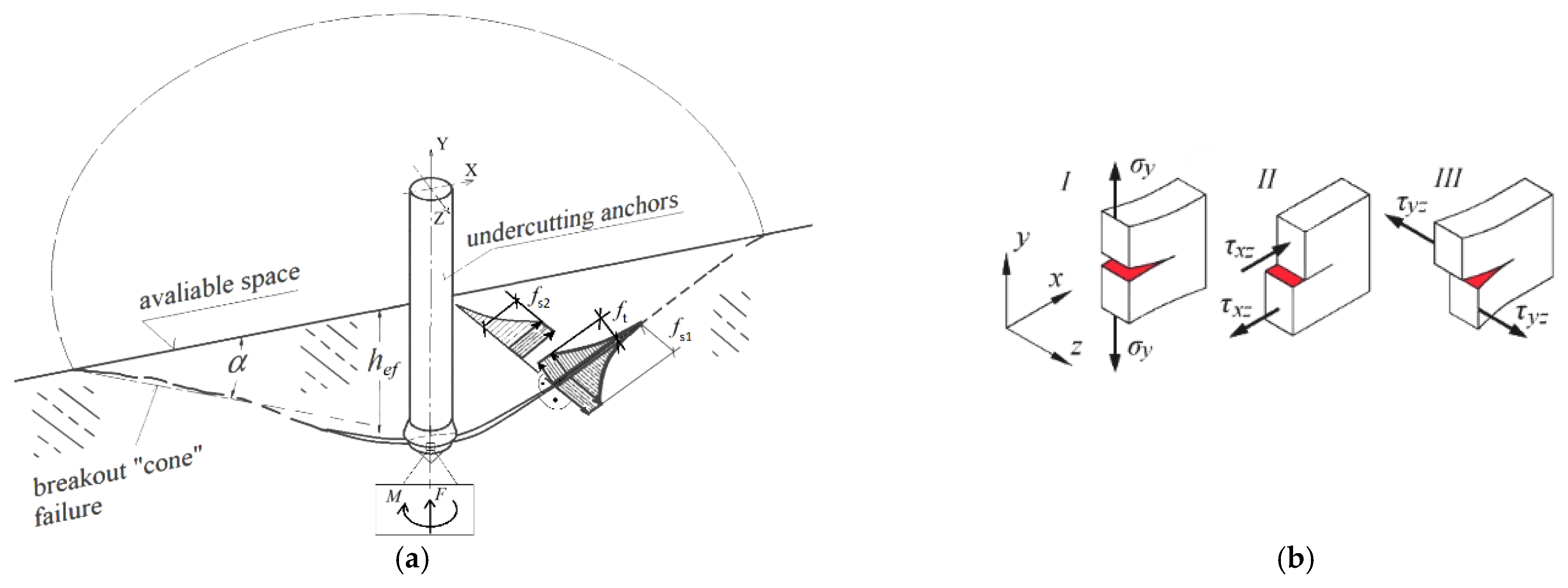
| Mine | fc (MPa) | Standard Deviation fc | ft (MPa) | Standard Deviation ft | k = fc/ft | φ (°) | c (MPa) | Rock | Description |
|---|---|---|---|---|---|---|---|---|---|
| Brenna | 58.8 | 9.29 | 3.9 | 1.17 | 15.1 | 53 | 6.0 | sandstone | Sandstone layered, weak |
Disclaimer/Publisher’s Note: The statements, opinions and data contained in all publications are solely those of the individual author(s) and contributor(s) and not of MDPI and/or the editor(s). MDPI and/or the editor(s) disclaim responsibility for any injury to people or property resulting from any ideas, methods, instructions or products referred to in the content. |
© 2025 by the authors. Licensee MDPI, Basel, Switzerland. This article is an open access article distributed under the terms and conditions of the Creative Commons Attribution (CC BY) license (https://creativecommons.org/licenses/by/4.0/).
Share and Cite
Jonak, J.; Karpiński, R.; Wójcik, A. Parametric Study of the Effect of Anchor Drive Bolt Geometry on Stress Distribution and Direction of Crack Formation in the Rock Medium. Materials 2025, 18, 4136. https://doi.org/10.3390/ma18174136
Jonak J, Karpiński R, Wójcik A. Parametric Study of the Effect of Anchor Drive Bolt Geometry on Stress Distribution and Direction of Crack Formation in the Rock Medium. Materials. 2025; 18(17):4136. https://doi.org/10.3390/ma18174136
Chicago/Turabian StyleJonak, Józef, Robert Karpiński, and Andrzej Wójcik. 2025. "Parametric Study of the Effect of Anchor Drive Bolt Geometry on Stress Distribution and Direction of Crack Formation in the Rock Medium" Materials 18, no. 17: 4136. https://doi.org/10.3390/ma18174136
APA StyleJonak, J., Karpiński, R., & Wójcik, A. (2025). Parametric Study of the Effect of Anchor Drive Bolt Geometry on Stress Distribution and Direction of Crack Formation in the Rock Medium. Materials, 18(17), 4136. https://doi.org/10.3390/ma18174136






